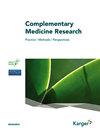选择性阿育吠陀辅助治疗可调节接受放疗的梨状窝癌患者的免疫反应和氧化应激:病例研究。
IF 0.8
4区 医学
Q3 INTEGRATIVE & COMPLEMENTARY MEDICINE
引用次数: 0
摘要
导言--下咽鳞状细胞癌的预后较差,尽管采用了根治性手术、放疗和同步化疗等常规治疗方法,但此类患者的相对生存期只有 25%。病例介绍 - 一位长期咀嚼烟草和槟榔的 62 岁男性患者出现吞咽困难和声音嘶哑,被诊断为梨状窝恶性肿瘤 III 期 II 级。患者接受了 9 个周期的新辅助化疗,使用紫杉醇注射液 100 毫克和顺铂注射液 40 毫克。随后,他被转到我院接受根治性放疗,同时接受阿育吠陀辅助化疗。我们使用钴 60 放射源对双侧面部和颈部进行了总剂量为 70 Gy 的放射治疗,共分 35 次进行。患者还同时接受了 6 个周期的化疗,每周使用 40 毫克顺铂。他还接受了计划周密的阿育吠陀辅助治疗,包括口服阿育吠陀药物(OAM)和排毒治疗(Panchakarma)。据观察,该患者在放疗期间和放疗后的口腔炎、口臭、味觉改变、吞咽困难、恶心等放疗不良反应均明显减少。Karnofsky 和 QoL 评分显示患者在整个治疗过程中都很健康。5 年后,正电子发射计算机断层扫描(PET CT)显示没有 FDG 阳性局部区域复发或远处器官受累,这意味着无病生存期(DFS)。在治疗过程中,对各种趋化因子、细胞因子和氧化应激进行了评估,以观察肿瘤微环境。结论--本病例为HNC,Ⅲ期,Ⅱ级,属于高分化、高风险的下咽癌,预后较差。患者除接受放疗外,还选择了阿育吠陀疗法,该疗法持续了 5 年。因此,我们强调,在这个病例中,放疗的副作用最小、免疫调节、炎症和氧化应激减少以及良好的生活质量都归功于 OAM 和反复排毒的 Panchakarma 治疗,并辅以健康的饮食和良好的生活方式。这项研究的亮点在于对患者免疫反应的显著影响以及氧化应激的减少,从而使患者的 DFS 达到 5 年及以上。本文章由计算机程序翻译,如有差异,请以英文原文为准。
Selective adjuvant Ayurvedic treatment modulates immune response and oxidative stress in patient with carcinoma of pyriform fossa, undergoing radiotherapy: A case study.
Introduction - Hypopharyngeal squamous cell carcinoma has poor prognosis with only 25% chances of 5 years of relative survival in such patients in spite of conventional treatment including radical surgery, radiotherapy and concurrent chemotherapy. Case Presentation - A chronic tobacco - betel nut chewer 62-years-old male patient had dysphagia with hoarseness of voice diagnosed with stage III, grade II malignant pyriform fossa. The patient underwent 9 cycles of neo adjuvant chemotherapy with Inj Paclitaxel 100 mg and Inj Cisplatin 40 mg. He was then referred to our institute for Radical Radiotherapy with Concurrent Chemotherapy with adjunct Ayurvedic treatment. A total dose of 70 Gy of radiation with cobalt 60 source was administered to the bilateral face and neck, in 35 fractions. Patient also received 6 cycles of concurrent weekly chemotherapy with Inj Cisplatin 40 mg. He received well planned adjunct Ayurvedic treatment in the form of Oral Ayurvedic Medicines (OAM) and Detoxifying treatment, Panchakarma. All the measured adverse effects of radiotherapy such as Stomatitis, Xerostomia, Taste Alteration, Dysphagia, Nausea etc. were observed to be remarkably low during and post radiotherapy in this patient. Karnofsky and QoL scores revealed patient's wellbeing throughout the treatment course. After 5 years PET CT scan revealed no FDG avid loco regional recurrence or distant organ involvement implying Disease Free Survival (DFS). Various Chemokines, cytokines and oxidative stress were assessed during the course of treatment to observe tumour microenvironment. Conclusion - Present case of HNC, Stage III and Grade II belonged to high-grade, high-risk hypopharyngeal cancer with poor prognosis. The patient opted for Ayurvedic treatment besides radiotherapy which continued thereafter for 5 years. We therefore emphasize that in this case, minimum side effects of radiotherapy, immunomodulation and reduction in inflammation and oxidative stress along with good quality of life can be attributed to OAM and repeated detoxifying Panchakarma treatment supported with healthy diet and good lifestyle. The highlight of the study is the marked effect on the patient's immune response and reduction in oxidative stress leading to 5 years and beyond of DFS.
求助全文
通过发布文献求助,成功后即可免费获取论文全文。
去求助
来源期刊

Complementary Medicine Research
Medicine-Complementary and Alternative Medicine
CiteScore
2.90
自引率
5.60%
发文量
50
期刊介绍:
Aims and Scope
''Complementary Medicine Research'' is an international journal that aims to bridge the gap between conventional medicine and complementary/alternative medicine (CAM) on a sound scientific basis, promoting their mutual integration. Accordingly, experts of both conventional medicine and CAM medicine cooperate on the journal‘s editorial board, which accepts papers only after a rigorous peer-review process in order to maintain a high standard of scientific quality.
Spectrum of ''Complementary Medicine Research'':
- Review and Original Articles, Case Reports and Essays regarding complementary practice and methods
- Journal Club: Analysis and discussion of internationally published articles in complementary medicine
- Editorials of leading experts in complementary medicine
- Questions of complementary patient-centered care
- Education in complementary medicine
- Reports on important meetings and conferences
- Society Bulletins of Schweizerische Medizinische Gesellschaft für Phytotherapie (SMGP) and Deutsche Gesellschaft für Naturheilkunde
Bibliographic Details
Complementary Medicine Research
Journal Abbreviation: Complement Med Res
ISSN: 2504-2092 (Print)
e-ISSN: 2504-2106 (Online)
DOI: 10.1159/issn.2504-2092
www.karger.com/CMR
 求助内容:
求助内容: 应助结果提醒方式:
应助结果提醒方式:


